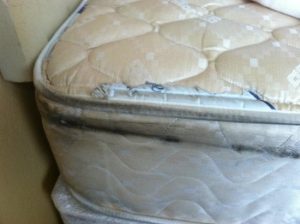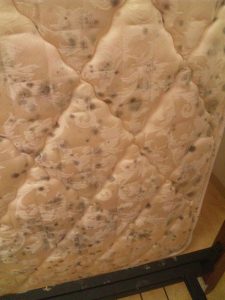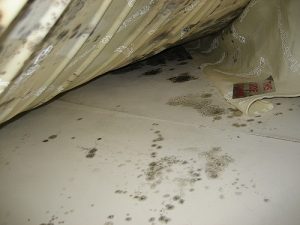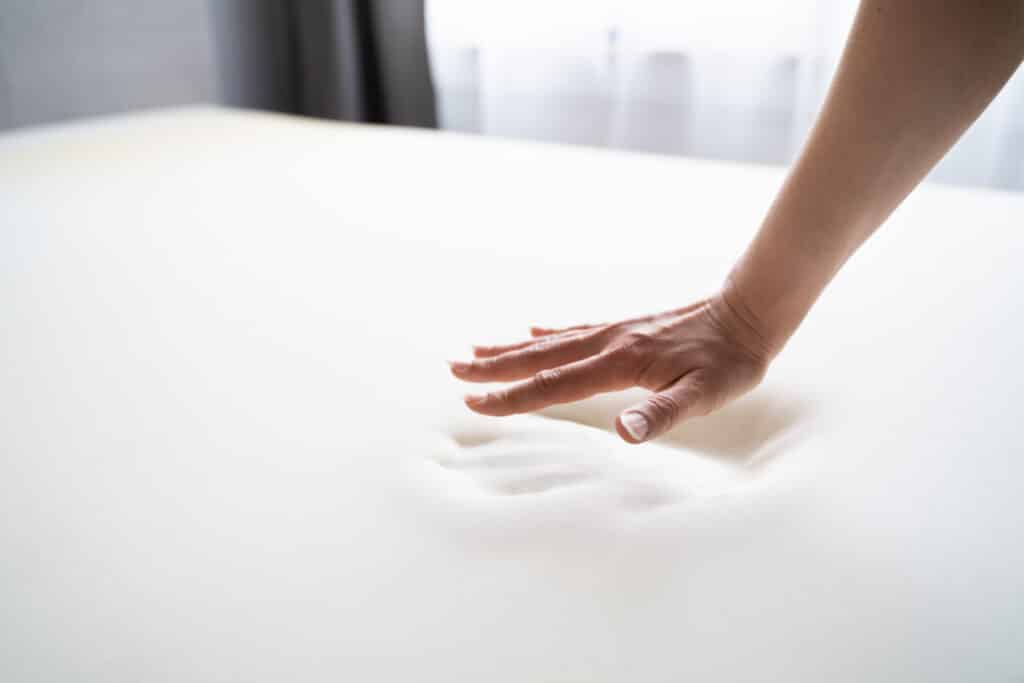Not only is mold disgusting, but it can also be dangerous to you and your family. While we might be more accustomed to hearing about mold in the bathroom or kitchen, it can also occur in the bedroom, especially underneath your mattress. To prevent mold, you need to understand what it is, what causes it, and how you can adjust your room to avoid it.
What Is Mold?
Mold is a type of fungi that are commonly found in homes and which thrives in moist environments. There’s also another type of fungi that you should be aware of, mildew, which is often confused with mold. In the case of your mattress, mildew is far more common, but most of us refer to it as a mold because we don’t understand the differences.
Mildew is a specific type of mold that has flat growth, and which remains on the surface of your mattress, allowing it to be easily removed. Mold, on the other hand, tends to creep deep into surfaces and pollutes them with mold. Fortunately, mildew can be quite easily removed, whereas mold will require much more serious treatments.
Mildew is typically easy to identify because it appears as black dots, spread out, and can be quite easily wiped off. Mold, on the other hand, has a fuzzier appearance like what you might see on old food and can be difficult to remove from the surface of your mattress. In almost all cases, the “mold” that you’re dealing with is mildew.
Mold In Mattress Symptoms

Mold or mildew is microscopic, to begin with, meaning that you won’t be able to spot the early signs until it has grown to become visible to the naked eye. This problem is especially prevalent among those who don’t regularly turn and check their mattress when they are changing the sheets.
Typically, the earliest symptoms of mold under the mattress is a visible appearance of small black dots, which you can notice far before you have any health problems or notice a stench. Keeping a close eye on your mattress is an essential tactic to guarding against the growth and occurrence of mildew.
Smell
The spores from the mold have a particularly persistent and strong smell which you might not associate with mold. Typically, when you think of it, you associate it with rotting food, which tends to smell rancid, whereas spores on your mattress can have a damp or dank smell which you might notice over an extended period.
If you start to smell this, you should continue to search for the spores so that you can solve the issue. Depending on where they are and how dense the concentration of mold, you may notice the scent before you see any large density of mildew on the mattress.
Health Problems
Spore exposure can cause serious health problems, especially for those who are already sick or suffer from severe allergies. Mold under your mattress is particularly harmful because you spend long periods in bed and are therefore exposed to the danger for far longer than you might be in another part of your home.
Exposure to mold for this extended period will typically become evident through allergy-like symptoms such as headaches, itchy eyes, congestion, and exhaustion. If you’re feeling these symptoms, especially shortly after waking up, it could be the exposure to mold or mildew that is causing the symptoms.
Usually, you’ll start to feel better shortly after leaving the infected area, whether that is to leave the house to go to work or even to another part of the house without mold. This sudden change in feeling is a common symptom of mold that is on your mattress as opposed to throughout your home.
Appearance

One of the earliest signs of mold is tiny black spots that will appear along the mattress, typically on the underside, which either touches the ground, bed slats, or box spring. This black mold is mildew, and if left it will progress and begin to cover the mattress, causing damage and releasing spores, which can have a severe impact on your physical health.
Mold tends to appear as a fuzzy layer in large segments, often in white or black color. While mildew is evident because of its dotty and black appearance, which is unique to this type of fungus. Mildew is far more common under mattresses, and you can identify it by seeing how easy it is to wipe off with a wet cloth.
While mildew will slide off the surface of the mattress with very little pressure or effort, mold tends to be more stubborn and can require further treatment to remove. Check our mattress cleaning tips and more help and advice on this.
What Causes Mold?
For mold to grow, it needs a dark and wet environment where it can thrive without being disturbed. The underneath of your mattress provides this by guarding it against direct light and transferring the moisture from your bodies you sweat through the night. This combination of dark and sweat causes mold to grow quickly and abundantly.
Usually, your mattress won’t hold that moisture in large quantities or for long. Your bed sheets absorb much of it, and when you’re washing them regularly, it’s removed before any issues can develop. Similarly, the circulation of air underneath your bed should dry it out quickly and prevent mold from appearing.
However, when your mattress is close to the ground, directly touching it, or lays on a solid box spring, air circulation is limited, and this adds in little extra heat and prevents it from drying out. Both of these factors allow the mold to increase quickly, causing severe problems.
Mold Under The Bed

Mold typically occurs on the bottom of your bed, but it is possible for it to appear elsewhere first. The reason why the underneath of your bed is the most common spot for fungus growth is that it gets practically no light exposure and the air circulation is limited. While the top and sides of a bed see sunlight and artificial light, as well as receive air every time, you lift your bedsheets.
To prevent this fungus from growing on the underneath of your bed, try to make a conscious effort to allow airflow under the mattress and bed. Open the window in your room as well as your bedroom door and a window in a different room, causing airflow throughout the home.
Similarly, ensure that there is a sizable gap between your mattress and the floor and preferably opt for bed slats rather than a box spring which completely prevents air from reaching the bottom of the mattress.
As always, it’s wise to lift up the mattress periodically to check for early signs of mold both visually and with your nose. When you do this, perhaps leave it leaning against the bed for a few hours, this will dry it out substantially, reducing the risk of fungus developing.
The Mattress-On-Floor Mold
The most likely circumstance for mold to develop on your mattress is when it is in direct contact with the floor. Regardless of whether your floor is carpeted or hardwood, the moisture is going to sit against the mattress, and no air can get to it to dry it out. Over time you have the perfect environment for fungus; warmth, dark, and moisture.
It’s unsurprising then that unless you are careful about regularly washing your sheets, minimizing moisture, and drying out the underside of the mattress, mold will inevitably develop. Ideally, you should purchase a raised bed that uses slats to allow significant airflow, but if this is impossible, you should lean the mattress against a wall for at least a few hours each week to let it dry out.
Mold On Popular Mattresses
Innerspring Mattresses
Regardless of all the fascinating and incredible technology that is used in spring mattresses, the mold is still possible. As long as there is a warm environment underneath the mattress where light can’t reach, and moisture begins to settle, the fungus will eventually grow and spread.
To prevent this, it’s essential to raise the mattress up from the ground as much as possible to allow greater air circulation. To promote dryness, you can also use dehumidifying machines and open the windows occasionally to create a flow of air throughout the home which can help dry it out.
Memory Foam Mattresses
These mattresses are made using a variety of different foams. The problem with foam is that it absorbs moisture and holds it incredibly well, meaning that the sweat and liquid from your body can be held in the mattress for a long time. This moisture can get to the bottom of the bed, where it can facilitate the growth of mold.
Memory foam mattresses are arguably more susceptible to mold than traditional coil or spring mattresses because memory foam lays flat against the ground and holds moisture well. These two factors ensure that there is less air flow against the bottom and there is plenty of moisture, both of which encourage the growth of fungus.



I have a Tempurpedic mattress and boxspring and they have brown blotches all over. I suspect mold and I wish someone could inspect it for me as I have physical problems.
Hi Tina,
If your mattress is still within its warranty period perhaps you should make contact with Tempurpedic directly for further help and advice on their product.
Many thanks
Good morning Lindsey, my husband and I have a resnick’s support posture, cloud comfort queen size futon mattress. Recently over the past year especially during the summer season we noticed that there were small white spores developing on the bottom side of our mattress, concluded that due to the fact that the mattress couldn’t breathe was developing these spores. I unfortunately have a terrible allergy to mold and we were curious if the white spores are being seen on the outside if the padding on the inside of the mattress is also infected. Looking forward to hearing your two cents on the matter 🙂 thank you for your time
I also have a tempurpedic – mold started in the center of its bottom box spring (which is on their company adjustable bed, and is spreading to the top mattress. I was getting ill for no apparent reason. Get rid of the mattress. NEVER by a tempurpedic!!!
My boyfriend has mold on the mattress and in pillows too. Whenever I visit I get sick and I can’t even be able to sleep? Whenever I wash his blankets and comforters they just smell fast and I’m always sick coughing. Please help I don’t know what to do anymore.
Unfortunately, it sounds like your boyfriend needs to now replace his mattress.
Replace boyfriend…!
Mimmy,
Sounds like your boyfriend needs to replace his mattress AND pillows. If he doesn’t want to replace the blankets and comforters, wash them with baking soda in addition to the detergent. If they still smell, re-wash and use white vinegar.
The protective cover for my memory foam mattress had mold on the inside and outside. I replaced the cover but could the mattress still be compromised?
Potentially, yes. See how it goes for the next month or so.
I have a mattress in my big rig. Saw some black spots, used white vinegar and bleach and let it set outside. Is that going to get rid of it? I still see faded black marks is this safe to use?
Find a new boyfriend, that’s just disgusting.
Im with David on this one.
I have had night sweats for over a year now, sometimes so bad that I have to get up in the middle of the night and change my gown. Recently, I have noticed a peculiar smell and not sure where it is coming from. I suspect it might be mold. So far I have seen no signs of mold . The smell is not especially “bad” but a really odd odor. Is it possible there is mold on the inside of the mattress that maybe has not surfaced yet. Not sleeping well either. The mattress is a regular boxspring and mattress, no kind of memory foam. Thanks for your help.
Hi Irene, as you mentioned, yes it could be mold beginning to form due to damp conditions caused by frequent night sweats. If you have a spring mattress it could be forming within the inner chambers, out of sight. Depending on the type of mattress, you may be able to see it under the cover. If the cover is removable and washable in any instance I suggest removing and washing in the laundry. Also, if the mattress is reducing your sleep quality, perhaps it’s time to change it, especially to keep on top of your health. If budget is of concern, consider a mattress topper with a removable and washable cover. That way you can replenish your comfort, and wash the cover once a week/fortnight to remove the sweat from the fabric, thus reducing odor and bacteria build-up.
Hi. We have a memory foam mattress bought I guess 4 to 5 years ago. Recently just discovered a 30 inch by 30 inch mold or mildew underneath the mattress. I cleaned it with pure white vinegar but the stain still there. I air dried it with the heater and put on the fan and air purifier. What should I do? It’s a king-size bed. Should I toss it out or cleaned it again, and with what? Is getting a professional reasonable? Please help. Jen
Hi Jen, 30 x 30 is a big patch. And if it’s not going, considering your mattress is circa 5 years old, it may be time to invest in a new mattress. You could get a quote from some professionals, but considering the mattress is degrading and is only a few years away from the recommended ownership timeframe, it may be more cost-effective to buy a new mattress, even if it is a budget one.
I have a memory foam mattress that was on a bed that was pretty infested underneath (platform bed w/drawers). I don’t see signs of any mold. Should I assume it’s there anyway?
The chances are it may have become moldy. If the mattress is quite old perhaps you should consider replacement
Lindsay,
I just bought a truck camper and ripped out the old mattress and everything that was under it. We installed our new mattress on top of new low pile carpet. Will this be okay to prevent moisture from building under the mattress?
Hi Cindy, I can’t say for sure as I haven’t seen the underneath of your mattress. Provided it was nice and dry when you laid the carpet you should be fine.
Hi ,
I have a memory foam matress on the floor and recently noticed a patch of mould on the underside. Thankfully the matress cover is removable and i managed to remove it and the mould just seems to be on the outside (which is in contact with the floor) rather than the inner side too. Does that mean that the foam mattress has been spared ?
It sounds like you should be fine 🙂
Hi Lindsay. I’m curious if you could share more on how to identify mold on memory foam. My apartment is quite damp, and I had my mattress on the floor for a few months (moved to a damp environment from the desert, so not accustomed to this). There are not parts of the memory foam that appear gray (originally it was cream). There are not mildew patches, and I can’t tell whether the gray is fuzzy, but it is present in various parts of my mattress. Is this mold, or could it be something else? Thanks!
Hi Lindsay. Thanks for your informative post. I have a Design Mobel cotton, wool, latex and pocket spring mattress. It has synthetic dream foam supporting the pocket springs around the whole edge of the mattress. Since buying it 17 yrs ago, it has been stored for over half it’s life. Part of its time in storage it was flat but for 3-4 years it was on its side, in a plastic bag showing no visible signs of moisture but with its edge (in plastic and on carboard) on a concrete floor. The storage shed was dry, no windows but not black-out dark, and the corrugated iron got hot in the sunshine. I have now brought the mattress out of storage and lent it to my daughter who has need of a comfortable, dust-free and mould-free mattress as she is sleeping long hours and recovering from a long illness (which possibly began due to a mite or a mould overseas). I cleaned mildew (and maybe a very small amount of mould that left discolouration) off the wool bottom but I think the edge that was resting on the ground is generally yellowed or darkened and I can smell a faint dusty or musty smell. The mattress has mould resistant fabric and latex except for the cotton around the springs and the dream foam packing along the edges (which rested on the concrete floor). Is there a way I can ensure the mattress is free of mould and safe for her to sleep on? (Many thanks in advance).
Hi Krystyna,
Although it sounds like you took the best possible storage methods, based on your description, it sounds like you may have mold set in, possibly due to years of condensation building up in the plastic packaging or some other means. Unless it was completely sealed airtight, there’s no guarantee of keeping the mattress 100% fresh during storage. Given your daughter’s health concern, I wouldn’t second guess and would opt for a new mattress, even if it’s a relatively low-cost type that you opt for.
I have a leather couch that contains a mattress. The couch has visible mold on the outside and the inside edge beside the mattress. Does this mean the mattress has most likely been compromised? The couch was supposedly cleaned by a mold remediation company, but I’m afraid to use it now.
Hi Linda, yes, sadly it sounds like you have a mold issue
Hi, I have a very expensive box spring new mattress, I bought a waterproof terry towelling mattress cover to protect it and keep it looking new. My mattress sits on top of a leather slatted base but the base has no legs on so it is quite low down. Recently I have noticed a musty odour around the bed since putting the cover on, could this be damp or something else? The mattress is only a few months old and has never got wet, I only noticed the smell since we have had the waterproof sheet on?
It could be some form of condensation or moisture building up somewhere under the bed. Perhaps somehow raise the whole bed and increase the airflow for better ventilation, or try testing without the cover.
I recently discovered white mold growing on the underside of the draws under my bed (a kind of cardboard/wood composite). I’ve since cleaned and treated the whole bed and vacuumed and aired the mattress. There was never any sign of mould or mildew on the mattress itself but still smells pretty musty. Do you think the smell lessen over time (with lots of airing)? Anything I could do to speed things up?
Sounds like you’ve taken all the right steps. I think the smell will dissipate quite soon with good ventilation.
We are thinking about purchasing a tempur Cooltouch mattress.
It’s to go on a solid base which is on a French iron bed frame but I am worried about mold. Are they more susceptible to mold than the spring traditional mattresses? We have had no trouble with our old one.
The Tempur Cooltouch is an excellent mattress. Most all-foam mattresses are more susceptible to mold compared to traditional innerspring. However, this shouldn’t put you off. If you keep the mattress well ventilated and use a mattress protector you will significantly reduce mold occurrences.
I have a sleep number bed that is 15 years old. Recommended ownership is 20 years. It is the type that is filled with air inside. I have had night sweats for over 7 years. I have not noticed any mold, but a recent mold test due to digestive issues, showed me positive for mold. I live in a 3 year old house, so I doubt it is the house. Can mould grow in these air filled mattresses ? If so, how would I know ?
Not to my knowledge, but that’s not to say it isn’t being well-hidden on the surface. 7 years worth of night sweats can have a detrimental effect on the exterior of any mattress.
Hi I have a igel mattresses with storage bed. 2 year’s old we lifted it up about a month ago and it was fine but now the underside is full of circle mould and we haven’t a clue why. We have no mould anywhere else. Any ideas appreciated.
I am looking for a mattress to buy for my 3 season cottage. We live in northern Ontario, so the temperatures get to -40. I originally wanted a foam (boxed) mattress such as the Endy, but after further thought I’m not sure it is a good idea as it will be in the cold weather for about 6 months out of the year. What are your thoughts – should I purchase a spring mattress or do you think a foam mattress will hold up to the temperature changes ?
Hi Raeanna,
I think an innerspring mattress would be best for such extreme cold. Memory foam would’ve been good for keeping you warm, but may not be great for mold long term.
What about mold on air beds. I sleep outside 6 months of the year and I noticed a urine smell.when I looked under the foam pads there was black mold. Help. What can I do to prevent this from happening
Just got a Tuft and Needle foam mattress noticed a small spot on the underside. Took over the mattress fiber noticed it seeped thru a little bit it’s not black or anything like the cover was. Just looks like a little Stain now on the foam. Should I go ahead and clean it with a cleaning solution and dry it? If so what kind of cleaning solution is recommended? I was going to just use bleach and water.
If it’s new I would contact T&N in the first instance incase you have further issues with the mattress later. Best to let them deal with this under warranty.
They don’t cover mold in the warranty as this just happened to my mattress from them.. Nasty!
I had a mattress sitting in some water for 3-4 months in storage. When I got it, it was wet. Since then I have kept it in garage to let it dry. It has dried up and the smell has gone as well. The protective cover had black spot on it. I am getting it professionally cleaned. Is there a way to know if there is any mold inside. Paid a lot of money for the mattress and would love to save it..
If it was wrapped and sealed in a plastic covering it should be ok. Also, if the mattress has a zippered cover you can check it removing it, otherwise there isn’t a way to know for sure at this stage.
Hi Lindsay, I moved into a mobile home a few months ago and it turned out the furnace was broken. It’s working now but it was down for about 4 weeks, so it was pretty cold in the home and I’ve heard mobile homes can have moisture issues. Now I’ve noticed my mattress (10 months old) has a strange smell – almost like decomposition. I’ve inspected the whole mattress and there are no other visible signs of mold or mildew. I’ve also vacuumed it and done the baking soda trick. The smell is still there. Is this mold? Is there anything I can do? The mattress is almost brand new. Thanks for any advice.
If there’s light brown specks on the mattress, are they mold?
I was told it’s mold coloration and the cleaning company said they cannot remove the stain but only the mold dust and spores by sucking them out and then applying uv light over.
1. My question is, if they are sucked out and removed, why would the coloration still remain?
2. There seems to be 2 types of professional mattress cleaning method. Dry cleaning method and the wet steaming method (extraction and hot steaming).
Which cleaning method is best when there’s mould/mildew on mattress? I.e. those brown specks.
Thanks!!
I sleep on a love seat that has a twin size hide a bed and memory foam mattress. I noticed that the mattress cover molded, as well as the gauze type material around the mattress and the mattress itself has a little stain on it like a coffee stain, which I believe is mold. If I clean the memory foam mattress with suggestions above, do I need to put a cover over it? If yes, can I used the cover that was on it, as I have washed it with the sanitizer setting on, on the washer.
If I have to purchase another mattress, like a Pure Green 100% Latex topper, do I need a mattress cover on that for my hide-a-bed? And will this one mold too. Do I have to keep airing out the mattress after each night of sleeping?
We have a king-size bed with a protective cover on it at all times. We started to notice yellow large that look like pee stains randomly on the mattress… It’s on a platform only 4 years old we bought it all together at the same time. Our room has been damp at certain times of the year. We also had a little dog who was 16.5 she had congestive heart failure so she took diuretics. I would cover the bed in peapods sometimes she would pee in the night. She passed away a year and a half ago . No new Stains have come since . Anyway that that is what is causing the staining. How do I find out if it’s mould? Thanks in advance this has been very helpful to read all other comments.
Hi have a alvescot Hypnos mattress I’ve discovered mould at the head end of the mattress I do sweat a lot during the night we keep the bedroom door open all night I thought the woolly lining would help. Help
Try to dry the mattress in the sun for now, but going forward, when you wake up in the morning, don’t make the bed. Leave the sheets exposed so the mattress gets plenty of air.
It was by chance that I noticed a leak from the pump near the water tank in the cupboard; I don’t know long the leak was there going into the concrete, but I knew something wasn’t right over a month ago as the air seemed moist, after using a dehumidifier constantly for nearly a week it certainly held a lot of water, but my main concern was the damage to the bedroom carpet as I actually thought the musty smell was from the underlay, so they were ripped out along with the underlay and replaced with laminate flooring now … But there’s still a smell and boy I have cleaned everywhere, and I now believe the itchy eyes, sneezing and headache from the mattress… The thing is I see no sign of any spores or mold on the mattress but under the bed, we have packed it with a lot of plastic storage boxes , so I see why you said the mattress needs air …. Could this problem happen deep within the mattress giving off spores on the air and yes purchased a air purifier too .
Yes, absolutely, it can cause your issue. Try drying the mattress outdoors if the weather permits. Place it back on the bed, this time without the boxes underneath. But in all honesty, given the extent of the symptoms described, you probably need a new mattress.
My Saatva twin mattress (4 years old) has very light blue deposits in the indentations. The mattress cover is all blue in spots where my upper body is when sleeping. There is no musty odor. I think it might be mold?
Yes, sounds like mold, unfortunately.
I just received an expensive NEW Natura of Canada Greenspring Ultra Plush mattress from delivery people yesterday. It was inside plastic and then also inside a closed box. It feels somewhat damp on top. There are very small grey spots in several places on top. Seems like mold? Also one slightly larger greenish yellow smudge near a corner on top. It was shipped from Canada THREE weeks ago and seems to have sat in a freight shipping location for a long time before they finally brought it to me. Should I insist it be taken back? Or will drying the top (as the seller suggested) and wiping off the grey spots be sufficient?
As it’s so new I would speak to the company and ask for a replacement
Hi there, my daughter has been suffering from severe urticaria for several weeks, which we thought was stress-related. Last night, we discovered horrendous mold in the bedroom. The really bizarre thing is it’s in the bottom of her wardrobe and covered all her boots and shoes with a white/grey furry substance, in between some of the hanging clothes but not on the wardrobe surfaces themselves, which seems strange, and also not in the other side of the shelving, I opened her ottoman bed, and sure enough, there’s a load of the same greyish furry substance all over her clothes and bags and stuff that’s stored under the bed. The top few slats are speckled darker, and there are a few very small patches on the underside of the mattress.
The roon has very little ventilation as she never opens the window and lies for hours in bed ( teenager !), so, everything that can be machine washed at 40deg, like clothes, bedding etc, I can solve but is a mattress cleaning on the surface sufficient or will it have travelled inside? Will it just come back? The mattress is literally a year old and has prob only had 6 mths of sleeping in total so otherwise, it’s spotless, with no sign of any marks anywhere else it looks brand new.
Is white wine vinegar and water the best thing to clean it and the wooden bed slats?
Taking her back to the doc for more heavy antihistamine today and more creams and moved her out of the bedroom until I can “decontaminate“ it, yuk, but in one way, I hope that’s the issue, at least it’ll go away when the room is cleared!
One other question, can mold travel on fabric? She had horrendous mold in her student accommodation and was wondering if it’s travelled back on her belongings and the lack of airflow in the room has created a breeding ground ?! I feel itchy myself just talking about it, headed up there with rubber gloves and a mask shortly !!!
Hi Samantha,
Sounds terrible. As you say, clean everything on a hot wash, and the slats with mold-removing cleaning products. Water and white wine vinegar is good but perhaps go for stronger options purchased from the shop. Also, the mattress is probably in a bad way considering the rest of the room is as you described. Spot clean to begin with but to me it sounds like you need to replace the mattress because the mold from under the ottoman would have travelled up into the base of the mattress, no doubt. Such a shame considering it’s so new. Also, yes, mold spores can travel from place to place, but the room really does need ventilation, so it’s hard to say for sure where and how the issue originated.
How best to dispose of a double mattress just discovered in the back of the loft. It must have been up there for 35 years! Frightened to go near it. And don’t want to expose it to the rest of the house during removal, as is bound to be infested with bugs, mites or mold etc. HELP am losing sleep worrying about how to dispose of this and how to get such a big thing through a small loft hatch!
Wear a face mask and some dirty overalls. Get as much cling film as you can, 25-50 meters. Carefully wrap the mattress in its position with an abundance of cling film, so it seals everything in. Once you’re happy that it’s all sealed and wrapped up, you can try to roll it and get it down the hatch, ensuring you don’t tear the plastic wrap in the process.
My son spilt an orange drink on side of the mattress about a month ago. His mattress used to be on a wood platform bed and we recently switched it to a bed frame with slats. I just thought the spill stained the mattress never thinking of mold until this morning. The stain is orange and appears to have black stains within the orange. Not really in a dotty formation. I’ve cleaned it once with rubbing alcohol and put a fan on it to dry. The stain is still there, so I’ll clean it again. The mattress is only about 1.5 years old. Not super $$ but would prefer not to replace but will if it’s a health issue. My son has allergies and narrow passageways so is always congested so hard to tell if from mold or such.
I guess my question after that ramble is how do I tell it the mold is gone (if it is mold) and won’t return? Or do I just replace the mattress?
If it hasn’t disappeared by now after thorough cleaning and drying, then yes, a new mattress. However, I’m more intrigued to know if there is any other sources aggravating the mold, as a simple spillage if cleaned and dried properly right away shouldn’t cause such damage.
Hi ! Do you suggest a foam mattress should go on treated slats (say poly ) or untreated . I purchased some wood slats 4 inch apart, great support , but they came untreated and I have read untreated wood can cause mold as it retains water. Tempurpedic was actually sued for this but in that case it was a solid piece of plywood and not slats . Any thoughts ?
Hi. For utmost protection using treated slats is ideal.